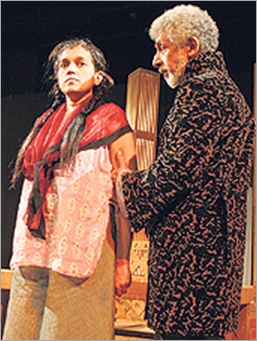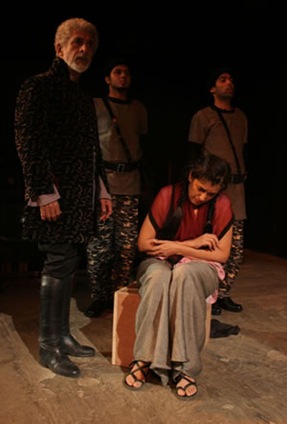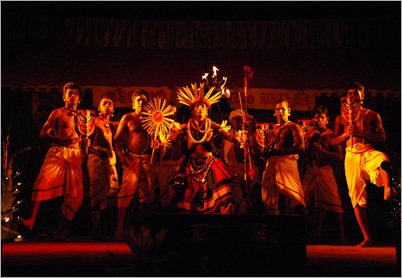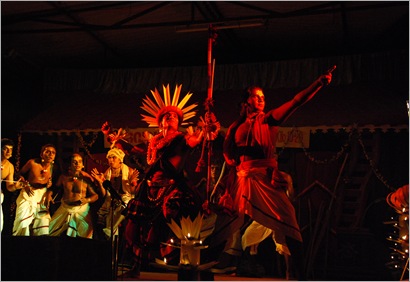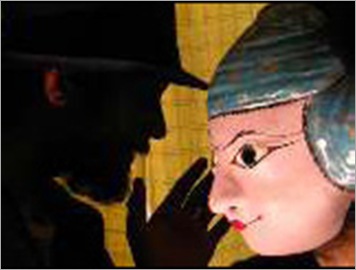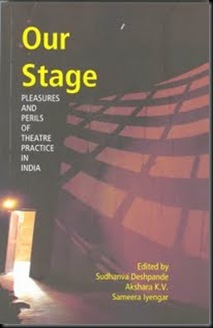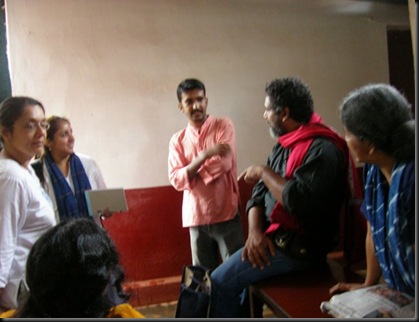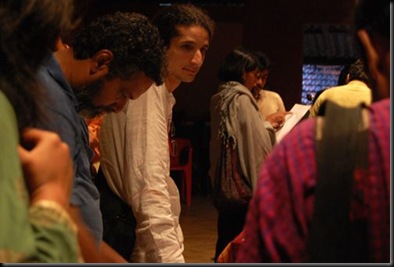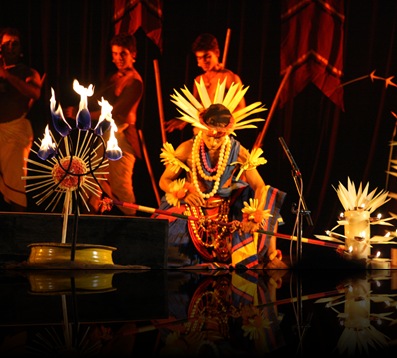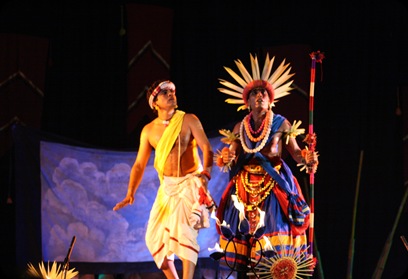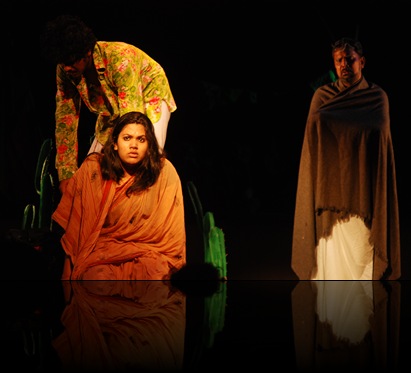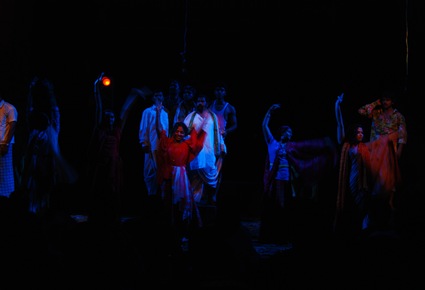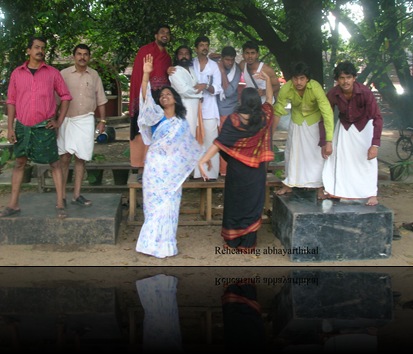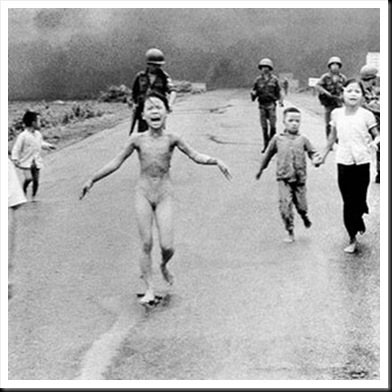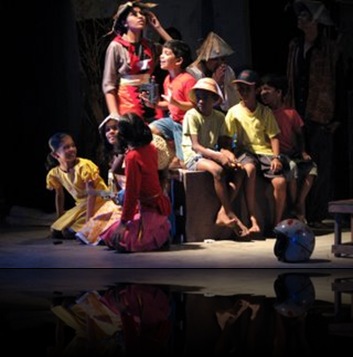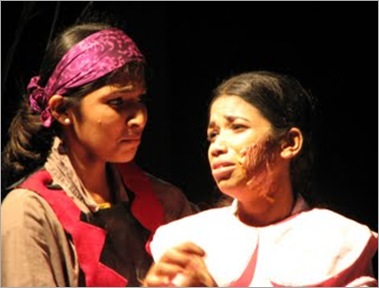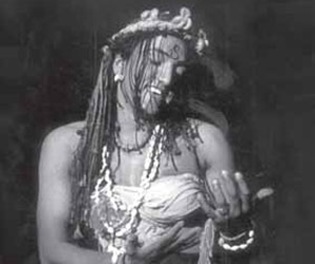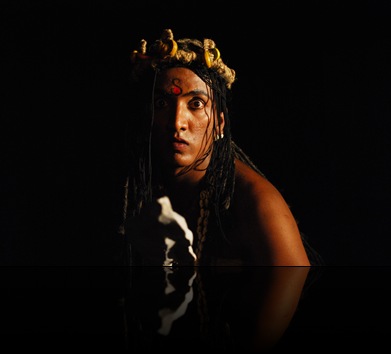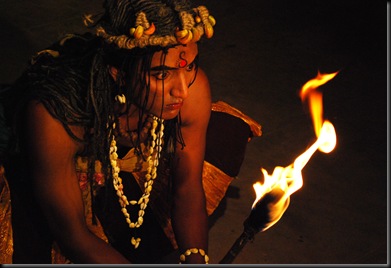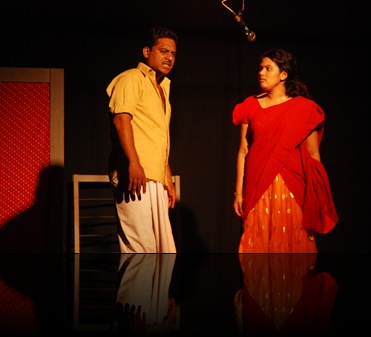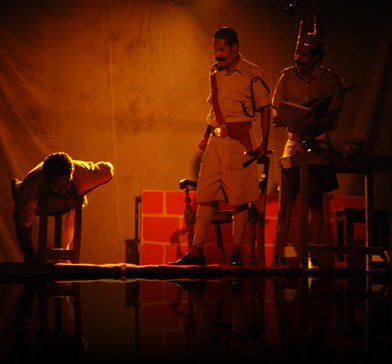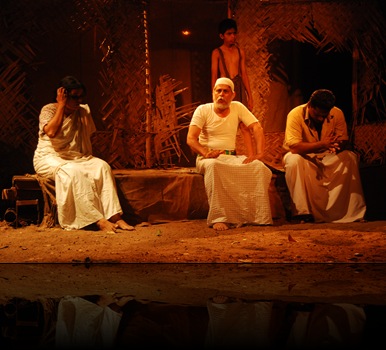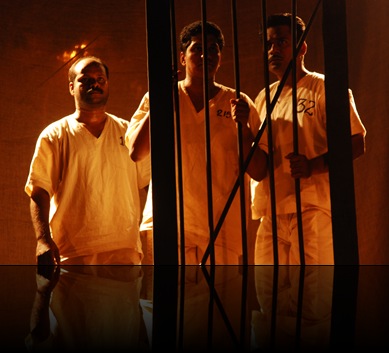ITFoK’09- Afro-Asian theatre festival at Thrissur, Kerala
The second chapter of the International theatre festival organized by Kerala Sangeet Natak Akademi will be focusing of plays from African continent and Asia. The plays from South Africa, Kenya, Pakistan and India will be presented in this festival from 20th to 29th of December 2009, at Thrissur Kerala.
ITFOK'09 is intended to provide a platform for addressing Afro-Asian cultural diversities through the medium of theatre. Performance should have relevance in the modern times while reflecting a strong cultural heritage inimitable to the countries they hail from.
The festival is organised by Kerala Sangeet Natak Akademi with the support of Sangeet Natak Akademi New Delhi, South Zone Cultural Centre, National School of Drama, and North East Zone Cultural Centre, and is dedicated to the memory of Bharath Murali, the late chairman of Kerala Sangeet Natak Akademi.
Malayalam Theatre Panorama (at 4.00 pm from 21st onwards)There will be an exclusive Malayalam Theatre Panorama which is intended to feature local theatre groups and ensure exposure to those theatre activists who are “working with limited resources” according to the organizers of ITFoK’09. The platform performances will have group or one-actor shows of duration up to one hour. Six play lets and nine one hour duration play have been included in this category
Seminar (11.00 am to 01.00 pm from 21st onwards).A series of seminars are being conducted as part of the festival, that may serve as a forum for communication, and exchange of ideas among theatre practitioners, activists, academicians and other experts. Prominent theatre personalities from South Africa, Pakistan, Kenya, India and elsewhere will take part in the session. The forum will cover the gap between the practitioners and academicians in the field of theatre, identifying unified streams of exploration. The topics of discussion are ‘Tasks of Acting & direction’, ‘Contemporariness of African Theatre & Indian Theatre’, ‘African Theatre, Visual media &narrative perspectives of Indian Theatre’, ‘Cultural similarities between India and African countries – primitivism & modernism’, ‘Evolving academics & syllabus’, ‘Malayalam theatre today’, ‘Major groups & theatre movements- Malabar and Travancore movements’, ‘Theatre n the Times of Globalization with special Emphasizes & Human rights’, ‘Talks on Play, Direction & Running of Chorus Theatre’ etc. The list of speakers include Naseeruddin Shah, Mark Fleishman, Anuradha Kapur, Keith Pearson, Vayala Vasudevan Pillai, Ananthakrishnan, Kumara Varma, Sanjana Kapur, Shahid Nadeem, K Satchithanadan, Anamika Haksar, Rattan Thiyyam and others.
Exhibition: An exhibition covering the history of Indian Theatre from pre-independent and post-independent era is also planned along with that cover the history of Shakespearean Companies in India, Parsi Theatre, and early Bengali Theatre, regional theatre movements etc.
Meet The Director (09 am to 11 am everyday from 21st onwards) An interactive session with the director of a play and the audience. following the day of performance is also envisaged.
The program Schedule
Day One 20th December 2009.
Inaugural Function – Naseeruddin Shah the famous film/theatre actor, will declare the festival open; at the presence of MA Baby, the Minister for Culture, Govt of Kerala. Music & Dance Performance by Sidi Goma Group, Gujarat (India), follows
The Caine Mutiny Court Martial - India - Naseeruddin Shah – Motley Theatre Mumbai - 07.00 pm
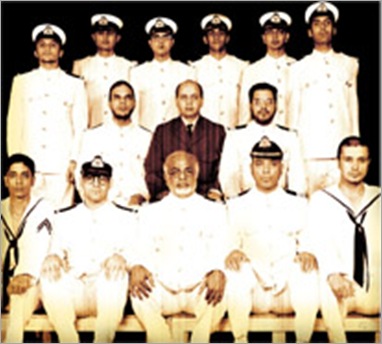 Based on a novel by Herman Wonk, The Caine Mutiny Court Martial is a complex portrait of what war and its accompanying stress does to people. The play also questions the possibilities of ‘Absolute Truth’ and the inevitability of war, would be best suited to engage with it. While examining the tragedy of war this post-World War II courtroom drama it probes the psyche of those at the forefront of battle, indicting the view that war is a stepping-stone to self-aggrandizement. This play was first performed by Motley in 1989.
Based on a novel by Herman Wonk, The Caine Mutiny Court Martial is a complex portrait of what war and its accompanying stress does to people. The play also questions the possibilities of ‘Absolute Truth’ and the inevitability of war, would be best suited to engage with it. While examining the tragedy of war this post-World War II courtroom drama it probes the psyche of those at the forefront of battle, indicting the view that war is a stepping-stone to self-aggrandizement. This play was first performed by Motley in 1989.
Day Two 21st December 2009
Narasimhavatharam (Nangyarkoothu) - Natanakairali Iringalakuda - 4.00pm
Poet Jayadever’s better half Padmavathi narrates a tale. The tale is that of half man half lion. The story gets completed in three parts. This theatrical performance by Kapila has used the devices of Koodiyattom and Nangyar Koothu. This performance piece represents the classical tradition in Malayalam theatre.
Athentha - Sathyajit - Nataka Souhrtham Thrissur - 5.30pm
Every year, Every day, I am walking - (South Africa) - Mark Fleishman - Magnet Theatre Cape Town - 07.00 pm
It explores what it means to lose the safety and security of home as a result of war and the consequences of that irrevocable loss in the life of a young girl. It traces the story of a refugee mother and her young daughter in Africa who loses family and home brutally and irrevocably, is forced to journey to a new place through many dangers and uncertainties. It is a piece about dislocation, about what home means, about Africa, about loss and about the first tentative steps towards healing and recovery as they flee from war in their once peaceful village, crossing borders and countries Using the style of physical theatre, much of the story is told through movement - a method employed by Magnet Theatre to communicate across barriers of language and culture. The creation of the play Magnet Theatre was also inspired by The Suitcase Stories - a book that was produced as part of a creative therapy process with refugee children in Johannesburg.
Day Three 22nd December 2009
Karanavarude Adhikaram (Power of an ancestor head) - Prabalan - Natakasangam Thrissur - 4.00pm
The Silence - Pradeep Mandur - Surasu Nataka Vedi - 5.00pm
MacBeki - South Africa - Mark Fleishman - Magnet Theatre Cape Town - 06.00 pm
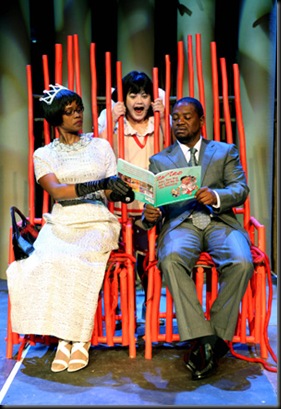 This transgressive variation of "Macbeth" gives literal expression to Karl Marx’s famous maxim that "history repeats itself as tragedy and then as farce". "MacBeki" draws inspiration from Shakespeare’s drama’, it is a reworking of Shakespeare’s tale of ambition, intrigue, fear, loathing, power, deceit and greed and it exists independently of Macbeth. The several hilarious visual tricks and tableaux added contribute to the overall subversive nature of the piece. This version is set in Luthuli Castle and the last days of the reign of the old King Maduba. The air is thick with treachery, suspicion and dark dealings as MacBeki, with his trusted friend and confidante, Lady Manta, dream of power. Unlike Shakespeare, Pieter-Dirk Uys who wrote the text does not spill blood in his play. He makes us laugh at the transparency of the ruling elite who lie to protect themselves at all costs.
This transgressive variation of "Macbeth" gives literal expression to Karl Marx’s famous maxim that "history repeats itself as tragedy and then as farce". "MacBeki" draws inspiration from Shakespeare’s drama’, it is a reworking of Shakespeare’s tale of ambition, intrigue, fear, loathing, power, deceit and greed and it exists independently of Macbeth. The several hilarious visual tricks and tableaux added contribute to the overall subversive nature of the piece. This version is set in Luthuli Castle and the last days of the reign of the old King Maduba. The air is thick with treachery, suspicion and dark dealings as MacBeki, with his trusted friend and confidante, Lady Manta, dream of power. Unlike Shakespeare, Pieter-Dirk Uys who wrote the text does not spill blood in his play. He makes us laugh at the transparency of the ruling elite who lie to protect themselves at all costs.
Sahyande Makan - The Elephant Project – India-Japan - Sankar Venkateswaran - Theatre Roots & Wings- Thrissur – 07.30 pm
Based on the poem by Vyloppilly Sreedhara Menon, the play depicts the conflict between internal and external realities as symbolized by an elephant reminiscing and hallucinating about his childhood. Set against the Temple Festivals of Kerala this turn out to be a multi-sensory and multi-lingual, inter-cultural construct, with the elephant portrayed by Japanese performer, Micari; who used her eyes, lips and body to animate many an unsaid emotion; and the silences seemed more powerful than the intermittent Japanese or Malayalam. Sankar uses a rich variety of instruments from Mizhavu to the Australian didgeridoo, to fireworks to recreate the feel of the Thrissur Pooram.
Day Four 23rd December 2009
Basthukara - Narippatta Raju - Navakerala Kalasamithi - 4.00pm
Githaa - Kenya - Keith Pearson - The Theatre Company - 7.00 pm
A young woman is drawn into the world of a group of street performers and through a series of stories, through song, dance and dialogue in a mixture of English and Swahili and other vernacular tongues, she works out her survival in this tough but thrilling environment. The performance speaks in street slang and revolves around street issues woven using agile dance steps, music beats and lyrics, plenty of narration, something closer to traditional non sense poetry. Githaa tries to tackle many issues at the same time, a bit of child labor and exploitation, women liberation, illegal gang’s infidelity and even art as a metaphor of leadership. The production, which has an episodic structure, “examines pre- and post-colonial history and the lessons that might be learned today from our past”, and “strives to engage the audience’s imagination through symbol and metaphor”
This musical performance was created during the first year of a Ford Foundation-funded project.
Kakkarassi - Pranavam Kottarakkara - 4.00pm
This play represents folk tradition of Kerala theatre. Kakkarissi is the blend of dance, enactment and music.
Sauti Kimya - Kenya - Keith Pearson - The Theatre Company - 7.00 pm
Sauti Kimya was originally inspired by the Taita community’s concept of the fight – a place where all conflict is put on hold, a place of resolution and reflection. The performance explores the use of modern day brags in Kenya through a layered texture of music, poetry, dance and dramatic action. – A show celebrating cultural and environmental life. The Audience members are invited to participate in an interactive workshop performance.
Day Six 25th December 2009
Thazhvarayile Paattu (Valley Song) - P.A.M. Rasheed - Theatre of Good Hope - 4.00pm
Athirthikal (Boundaries) - Vinod, Kaladi - Dept. of Theatre, Sri Sankaracharya University of Sanskrit, Kaladi - 5.00pm
Ayussinte Pusthakam – India - Suveeran - Ravivarma Kalanilayam Kerala - 7.00 pm
Ayussinte Pusthakam (The book of life) discovers and reconsiders the basic issues of sexuality and sin primarily raised by the novel, written by C.V.Balakrishnan. The play stands as an independent text with its dynamic but semantically loaded stream of situations. Committed only to the reality of the psychological realm, the play is an attempt to deconstruct the oppressive mechanism of religious orthodoxy. Symbols get fused into the totality of dramatic experience. Set in a village in Kerala, this play explores the ideas of family, priesthood, sex and marriage through the knotty relationships of a grandfather, his son and grandson. The play asks whether the Sin itself is a natural concept or a historical construct.
Day Seven 26th December 2009
Bharathavakyam - Roy K.G – Rangachethana - 4.00pm
Zoo Story - Jayachandran C.K - 5.00pm
Hotel Mohanjadaro - Pakistan - Shahid Nadeem – Ajoka - 7.00 pm

Day Eight 27th December 2009
Karalmancharitham (Chavittu Natakam) - Kerala Chavittu Nataka Akademi- 4.00pm
When Hoona attacked France in BC 800, as instructed by Leo Marpappa, Karelman becomes the emporer. And later Karelman becomes the protector of the country and its people. This play represents a traditional phase in Malayalam theatre.
Baburaj - "Paaduka Paattukaara"- Sasidharan Naduvil - Act Lab Thrissur - 5.00pm
Sidhartha - India - M.G. Jothish: Abhinaya Theatre & Research Centre -7.00 pm
The play Sidhartha is a stylized adaptation of the celebrated novel by Nobel Laureate Herman Hesse, that captures the essence of philosophy, spirituality and the individual The enduring images, the choreography, music, costumes, , light and set design, the dynamism and the subtlety in the performance, makes the show a visual poetry on stage.
Day Nine 28th December 2009
Panthamenthiya Pennungal - Mini I.G - Sunday Theatre Kozhikkode - 4.00pm
Chakki's Chankaran - Jayaprakas Kuloor - Manam Natakavedi - 5.00pm
Spinal Code - India - C.S. Deepan - Oxygen Theatre Company Thrissur - 6.00/ pm
Gabriel Garcia Marquez's novel Chronicle of a Death Foretold has inspired this play which narrates the story of a murder revisited 27 years after its occurrence. On the wedding might of Angela and San Roman, roman discovers that his wife is not a virgin. Then her brothers started a revenge to kill the violator. The drama keeps oscillating between the past and present.
Burquavaganza – Pakistan -Shahid Nadeem – Ajoka -7.30pm
The satirical stage play "Burqavaganza" uses the image of the burqa as a metaphor for the double standards which exist in contemporary Pakistani society. Burqa is the image for the cover-ups in the society; it speaks about the hypocrisy and double standards, and reflects the feudal/tribal mindset. The play shows all characters (men and women) wearing burqas, including politicians, terrorist leaders and policemen. Issues addressed include gender discrimination, religious extremism, terrorism, love marriage and media programs promoting intolerance. Following protests from Islamist politicians, this play has now been banned in Pakistan.
Remember that Ajoka has performed its play "Bulha” in last year’s edition of ITFoK, 08 and they are coming back with two productions this year also.
Day Ten 29th December 2009
Pachcha (Green) – Surjith - Abhinaya Theatre & Research Centre -4.00pm
Valedictory Ceremony @ 5.00pm
Thayambakathrayam lead by Padmasree Mattannoor Sankarankutty follows.
Ashibagee Eshei (When We Dead Awaken) – India - Rattan Thiyyam - Chorus Repertory Theatre, Manipur - 7.00pm
The festival concludes with the celebrated Indian director Rattan Thiyyam adapting Henrik Ibsen's last play, "When We Dead Awaken" (1899), - a 'dramatic epilogue' to Ibsen’s naturalism and a return to the poetic symbolism of his earlier plays. In the play, a sculptor suffers "sorrows for a forfeited life. Ashibagee Eshei" centers on the non-reality of characters, symbolism; and a lot of metaphysical references. In this adaptation set to the Manipuri milieu, scenes from the original play are picked up and interpolated without altering the storyline and disrupting the continuity, or Ibsen’s dialogues. The dramatic change of the set between acts, gestures and body language of the performers, the use of chorus, and the use of surrealistic elements makes this “a Manipuri 'Ibsen' play for the global audience," as suggested in Thiyam's directorial note.
Admission to the festival is controlled by delegate passes priced at 200 Rupees that can be obtained from the Akademi office or branches of Vysya Bank. The fee for delegate pass for students is Rs.100.
